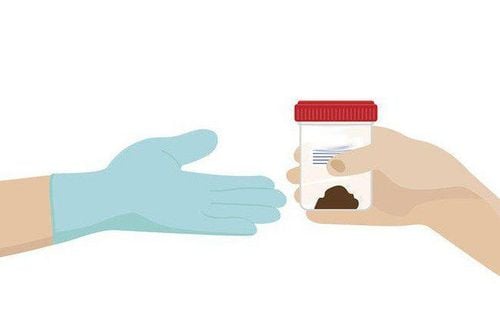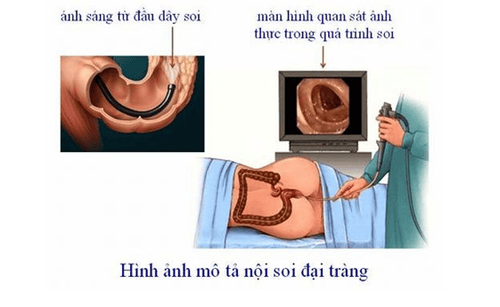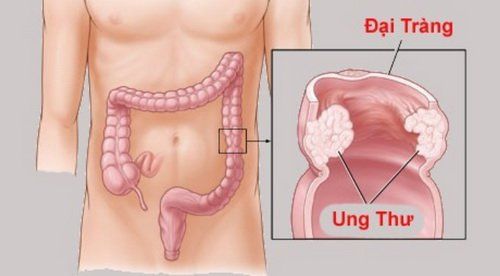This is an automatically translated article.
The article was written by Specialist Doctor I Nguyen Thi Minh Thuyen - Pathologist, Pathology Department - Vinmec Danang International General Hospital.Colon cancer is a common disease, the disease usually appears between the ages of 40 and 45 and the proportion of men is higher than that of women. Symptoms of the disease are not clear. Therefore, to make an accurate diagnosis, it is necessary to rely on clinical measures.
1. Signs and symptoms of colorectal cancer
Colorectal cancer may not cause immediate symptoms, but if it does, it may cause one or more of the following:
Change in bowel habits, such as: Diarrhea, constipation or Narrow stools, lasting more than a few days Feeling the need to urinate that won't stop Fresh rectal bleeding Blood in the stool, which can make stools black Cramps or abdominal pain Weakness and fatigue Uncontrolled weight loss. Blood tests show a low red blood cell count.

2. Diagnosis of colorectal cancer
If you have symptoms that suggest possible colorectal cancer or if screening tests show abnormalities, your doctor will recommend further exams and tests to find the cause.2.1 Medical history and examination
Medical history helps learn about possible risk factors, including family history. Do you have any symptoms, if any, when and for how long they started. Full body examination. Abdominal examination for any large mass or organ? Rectal exam by inserting a lubricated finger into the rectum to feel for any abnormalities.
2.2 Test for blood in the stool
If you see your doctor for some of the symptoms other than bleeding from the rectum or blood in the stool, he or she may recommend a test to check for blood in the stool that cannot be seen with the naked eye ( hidden blood), it could be a sign of cancer.
Fecal occult blood test should not be the follow-up test if an abnormal screening test has previously been performed, at which point a diagnostic endoscopy should be performed.

2.3 Blood tests
Your doctor may also order certain blood tests to help determine if you have colorectal cancer. These tests may also be used to help monitor your disease if you have been diagnosed with cancer.
2.4 Endoscopic diagnosis
Diagnostic endoscopy is like screening colonoscopy, but it is done because the person has symptoms or because something unusual is found on another type of screening test.
The doctor examines the entire length of the colon and rectum with an endoscope inserted through the anus into the rectum and colon. Special instruments are passed through the bronchoscope to biopsy or remove any suspicious areas if needed.
Colonoscopy can be done in the hospital outpatient department, or in the clinic.

2.5 Biopsy
If screening tests suspect colorectal cancer, endoscopic biopsy is needed. During a biopsy, the doctor collects small pieces of tissue using a special instrument through the scope.
2.6 Imaging tests for colorectal cancer
Imaging tests use sound waves, X-rays, magnetic fields, or radioactive substances to create pictures of the inside of the body. Imaging tests may be done for a number of reasons such as:
Look at areas that may be cancerous See how far the cancer has spread Determine the effectiveness of treatment. Imaging tests to look for colorectal cancer include:
Computed tomography (CT) scan: A CT scan uses X-rays to create detailed cross-sectional images of organs in the body. CT can show if colorectal cancer has spread to the liver or other organs. Ultrasound: Ultrasound uses sound waves to create images of the inside of the body. The transducer emits sound waves and captures them, which are then processed by the computer into an image on the screen. Magnetic resonance imaging (MRI): An MRI can evaluate abnormal areas in the liver or brain and spinal cord, and see how far the cancer has spread.

Chest X-ray: X-rays may be taken after colorectal cancer has been diagnosed to see if the cancer has spread to the lungs. Positron emission tomography (PET): PET typically uses a radioactive form of sugar that is injected into the bloodstream. A special scanner is used to create images of radioactively active areas in the body. Angiography: If your cancer has spread to the liver, this test can show the arteries that supply blood to those tumors. Angiography can also help plan other treatments for cancer that has spread to the liver, such as embolization.
Please dial HOTLINE for more information or register for an appointment HERE. Download MyVinmec app to make appointments faster and to manage your bookings easily.
Article references source: American Cancer SocietyMORE:
What is colorectal cancer screening? Is colorectal cancer curable? Colon Cancer: What you need to know














